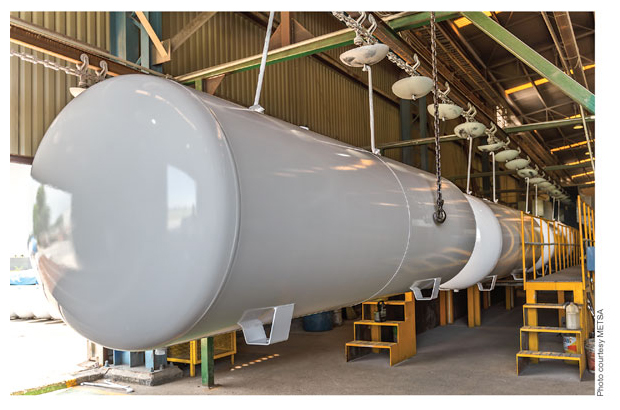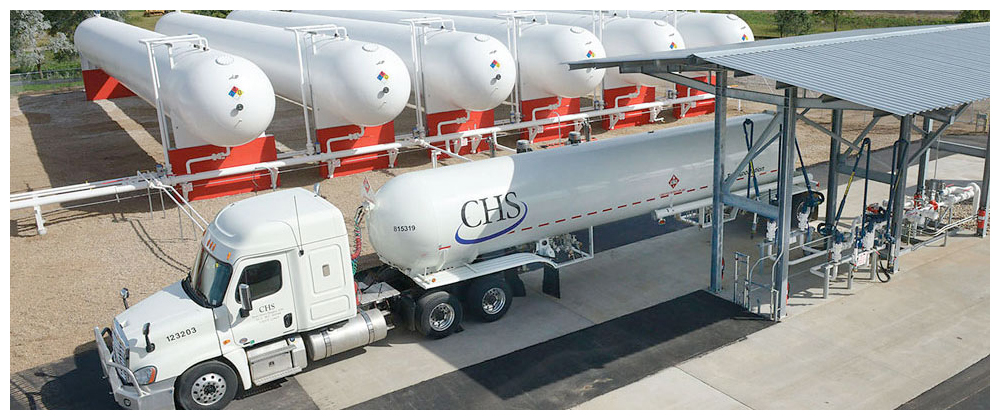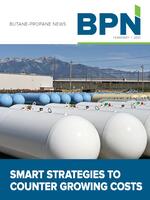
What is the best strategy for purchasing storage tanks, both large and small? Retailers are caught in a conundrum as the cost of steel drives tank prices higher and wholesale propane in the U.S. is now seen as a seller’s market because of international buyers.
LARGER TANK STRATEGIES
“One thing that we can count on these days is uncertainty, and fluctuating steel prices are part of that conversation,” said Tim Schweppe, general manager—Arrow Tank & Engineering, propane division (Minneapolis). “Not so long ago, we experienced something similar with the tariff announcements in March of 2018. Back then, steel prices sharply rose almost overnight and we were faced with making quick purchasing decisions to hopefully get ahead of the curve and soften the blow.” His company builds bobtail trucks, cargo tanks, transport trailer tanks, and large storage tanks up to 90,000 gallons.
“Since 2018, and particularly over the past year or so, prices from the mill became more ‘reasonable,’ whereas our cost averages were once again ‘normal,’ or whatever we perceive to be normal these days,” Schweppe told BPN. “As a matter of fact, we began seeing a downward movement below ‘pre-tariff’ prices and potential opportunities for a favorable 2021 material supply plan.”
Schweppe added he just wants stability for his customers and his own company. “Do you know anyone comfortable making a big-ticket purchase commitment with an open-ended contractual price?” he asked. “With the products we sell, each transaction is like buying a house. Would you be comfortable making a commitment to buy and not know the final price until you started moving the family and all your belongings into the new homestead? Of course not.”
“In early January we are seeing a steady rise of steel prices marching upward, putting them approximately 26% higher than October. However, many manufacturers have once again taken measures to stabilize prices by capitalizing on the earlier market opportunities, stocking up on inventory. My point being, do not scratch your plans based on what you are hearing regarding current market conditions. Instead, be sure to check with your supplier as many good deals are still out there to be made. Likewise, the same opportunities are available for bobtails and transport trailers,” Schweppe added.
“A combination of factors including COVID-19, political instability, supply chain insecurity, and low fuel prices have led to the installation of bulk storage at a level unprecedented in my 11 years at LPG Ventures,” said Ian Baanders, sales manager at LPG Ventures (Kearney, Mo.), which installs large propane storage tanks.
Brandon Ihm, owner of Energys USA Inc. (Waupaca, Wis.), agrees demand is strong. “The U.S. has gone from a net importer to a net exporter of propane over the past 10 years and Canada has also increased exports significantly,” he said. “Retail propane marketers throughout the Midwest, where we do most of our work, are feeling the effects of both U.S. and Canadian propane going to the highest bidder internationally.” Ihm said retail marketers are focused on adding storage to be more confident they will have two weeks of supply, which is the storage rule of thumb, on hand as product is not always as readily available as it used to be. “I’m seeing more retail marketers take a closer look at the return on investment for adding storage and consider the fewer miles and less wear and tear on vehicles this can provide. Larger storage tanks spread out across a market territory can achieve ROI quickly.”
In addition to increasing their own storage, Ihm said, many retail marketers are partnering with agricultural/commercial customers to share large storage tanks. “They may have an agreement with a grain dryer that the retailer gets to utilize the tank during the rest of the year when propane is not needed for grain drying,” he explained. “The retailer may decide to furnish the storage tank as part of an agreement over 10 to 15 years to be the exclusive propane supplier to the grain dryer account. Not only does this guarantee business for the agreed upon amount of time, but reduces the upfront cost of adding storage.”
THOUGHTS ON LARGE AND SMALL TANKS
 Superior Energy Systems (Columbus Station, Ohio) has been installing propane storage facilities as well as autogas refueling sites from many years. “We mainly deal with the large wholesale storage tanks, but do put 1000- and 1900-gal. tanks at our autogas sites,” said Derek Rimko, vice president operations. “Prices do certainly fluctuate and that is why we encourage making decisions fast when getting a quote on a project. Often, if much more than a week goes by after bidding on a project, we have to go back and confirm pricing on all of the materials that will be needed for the project.”
Superior Energy Systems (Columbus Station, Ohio) has been installing propane storage facilities as well as autogas refueling sites from many years. “We mainly deal with the large wholesale storage tanks, but do put 1000- and 1900-gal. tanks at our autogas sites,” said Derek Rimko, vice president operations. “Prices do certainly fluctuate and that is why we encourage making decisions fast when getting a quote on a project. Often, if much more than a week goes by after bidding on a project, we have to go back and confirm pricing on all of the materials that will be needed for the project.”
Rimko also sees more retail marketers adding storage than ever before. “They are being very strategic. They are wanting to increase their footprint, but also be efficient as they deliver to a wider region.” Rimko also notes that he has observed retail marketers are not hanging on to extra tanks as much as they used to. “I see them as being much quicker about selling off 500- and 1000-gal. tanks,” he said. “In many cases, they lose a customer and just don’t want the excess tanks and sell them. They end up buying more as they need them later.”
“Since August, steel costs have significantly impacted the cylinder and tank market,” said Bobby Weinberg, product director of industrial products for Worthington Industries (Worthington, Ohio), U.S.-based manufacturer of pressure cylinder and tanks. “We don’t foresee that changing in the near term. Indications are we may see some softening in the second half of the calendar year, but there is still a lot of uncertainty. Near term, availability is as much of a concern as price. There simply isn’t much material available due to strong demand from the automotive industry, delays related to COVID-19, and consolidation.”
Weinberg noted it is equally important to keep in mind that manufacturers are facing the same challenges as folks in the industry to operate their production facilities in a safe and responsible manner.
“The biggest key for anyone in the propane market (retailer, distributor, or otherwise) is planning,” he said. “Our supply chain is strained. All the cylinder and tank manufacturers are seeing unprecedented demand. This has been the case since March of 2020. Understanding your needs for the next 12-18 months can help secure supply and potentially provide cost savings. We have seen the retail marketers, distributors, and exchangers with inventory have been winning in this market.”
TerraVest Industries has a portfolio of propane-dedicated companies including Pro-Par inc., Fischer Tanks, Signature Truck Systems, Countryside Tanks, and Maxfield. TerraVest Industries’ propane division offers equipment for storage, distribution, and transportation. Glenn Buck, general manager at Pro-Par, offered several tips for tank buyers.
"Faced with growing manufacturing costs since the onset of the COVID-19 crisis,” he said, “it has become more important than ever to have in place smart strategies to counter the effects of growing costs affecting your business. Steel pricing is very volatile presently and subject to change at an unprecedented pace. This is when you need to rely on trusted suppliers that will be frank with you and help get you through this crisis. A frank discussion with your go-to suppliers is often the first strategy to initiate when things get tough. Rethink your supplier list and keep the suppliers that will go the extra mile for you—suppliers that offer a diversified product line that is focused on the propane industry, and that are there with you helping you grow by offering products that are key to your success.
“Basic values that you should expect from your suppliers are price, delivery, quality, and service in the order that matters to your business. You will do better by narrowing your supplier list and working with those that have similar values as you. Keep the suppliers that will go the extra mile for you. Your prime suppliers should be those that will be there with you offering excellent service, on-time delivery, advantageous terms, and a quality product.
“Work with trusted suppliers,” Buck suggested. “When things get tough, there is a need to work with trusted and reliable suppliers that will make every effort to meet your company’s procurement requirements. An honest conversation is required with your suppliers to ensure you understand.
“Optimize your supplier list. In the long game, you will do better to work with one or two key suppliers that you can trust. Keep the suppliers that will go the extra mile for you, that offer a diversified product line that is focused on the propane industry, and that are there with you helping you grow by offering multiple products that are key to your success.
“Bigger is not necessarily better,” Buck added. “Larger companies tend to focus on monthly sales instead of focusing on what is obviously more important, you, the customer. Smaller companies tend to be more responsive and flexible. Typically, these companies can make changes quickly to accommodate your needs. While it is difficult to put a cost on benefits of working with a company that has these qualities, it can be very beneficial to the growth of your business. The key is to find a business partner that has good pricing and delivers the goods that are important to you when you need them.”

SMALLER TANK CONCERNS
D.D. Hardy, national sales manager for Quality Steel Corp. (Cleveland, Miss.), sells numerous residential tanks that are 500 gallons and 1000 gallons in capacity, both above and underground. “Rising steel prices are nothing new to this industry,” he said. “We went through this a few years ago and came through it wiser, but this year the rise in steel came faster and hit historic highs. It’s important, prior to any year, that dealers work with their tank suppliers to review anticipated demand for the coming year, keep communications open as markets shift, plus take time to plan out any changes in tank sizes or quantities needed and where lead times are headed. Having three strategically located manufacturing facilities across the U.S. allows us to be closer to our customers and provide solid lead times and
customer service long after your tanks arrive. As busy as things get, you cannot sacrifice safety, quality, and customer service.”
Hardy noted he is seeing a trend in larger tanks over the last several years. “Some of that is a result of propane marketers using the larger tanks for tertiary storage and some of it is a result of our tanks being used not only to heat a customer’s home, but being used in the agriculture industry, which is good for the propane industry,” he explained. “Examples are grain drying and poultry.”
At Metsa Tanks (Monterrey, Mexico), Robert Kenney, managing director, said his company focuses on residential tank sales as well as autogas filling stations. “Customers sometimes buy smaller quantities when they perceive prices may move back down,” he said. “I don’t expect prices to decline significantly anytime soon. We will typically offer customers a better price if they make a larger commitment to take deliveries over the course of a year.”
Kenney said his company sells new tanks, but do offer contract refurbishing evaluated on a case-by-case basis. “Manufacturing in Mexico has some price advantages,” he said. “Also, we sometimes work with multiple companies working together to consolidate their orders into one big order if the companies are close in proximity.”
Chuck Kinnie, president of Shasta Tanks (Anderson, Calif.), built a business refurbishing domestic propane tanks in addition to his retail propane business. “We serve companies in California, Oregon, Washington, Arizona, and Nevada,” he said. “We apply two-part poly aspartic paint, which is very durable, and only install RegO valves.”
Kinnie learned the process of refurbishing tanks while in the retail propane business and began providing his services to other retail propane companies in the Western United States. “Customers often can’t tell the difference between a new and refurbished tank as long as valves are installed properly and the paint job is meticulous. We can often save them $200 to $300 versus a brand new tank. This adds up over time and a large quantity of tank purchases.”


